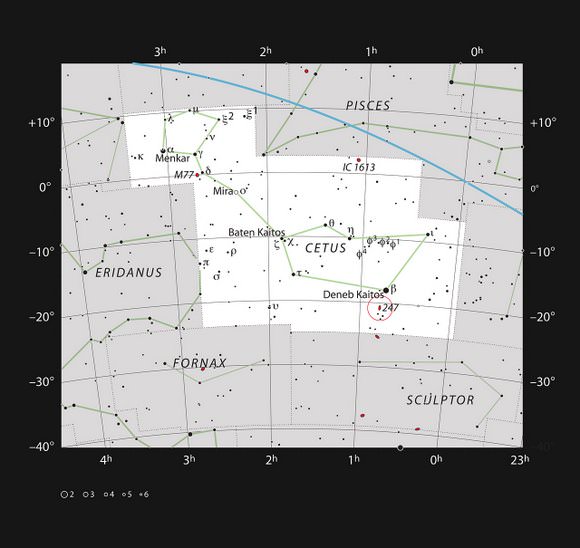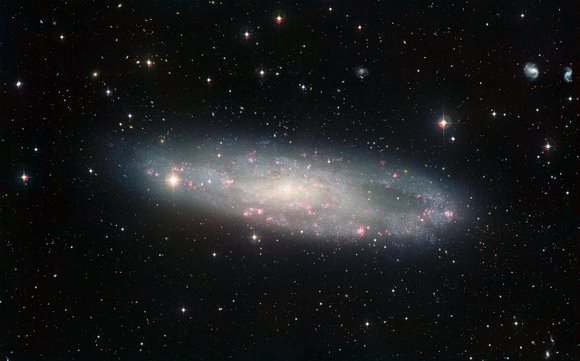[/caption]
One of our celestial neighbors, the spiral galaxy NGC 247, just moved about a million light-years closer.
Well, not really. But astronomers are retooling estimates of the distance to it, which was overestimated in the past partly because of the nearly edge-on tilt, shown above. The just-released image, from the Wide Field Imager on the MPG/ESO 2.2-metre telescope in Chile, shows large numbers of the galaxy’s component stars and glowing pink clouds of hydrogen, marking regions of active star formation, in the loose and ragged spiral arms. Numerous other galaxies can be seen in the distance.

NGC 247 (RA 00h 47′ 14″ – 20deg 52′ 04″) is one of the closest spiral galaxies of the southern sky, now believed to lie about 11 million light-years away in the constellation Cetus (The Whale). It’s part of the Sculptor Group, a collection of galaxies associated with the Sculptor Galaxy (NGC 253, shown in previous releases here and here). This is the nearest group of galaxies to our Local Group, which includes the Milky Way.
To measure the distance from the Earth to a nearby galaxy, astronomers have to rely on a type of variable star called a Cepheid to act as a distance marker. Cepheids are very luminous stars, whose brightness varies at regular intervals. The time taken for the star to brighten and fade can be plugged into a simple mathematical relation that gives its intrinsic brightness. When compared with the measured brightness this gives the distance. However, this method isn’t foolproof, as astronomers think this period–luminosity relationship depends on the composition of the Cepheid.
Another problem arises from the fact that some of the light from a Cepheid may be absorbed by dust en route to Earth, making it appear fainter, and therefore further away than it really is. This is a particular problem for NGC 247 with its highly inclined orientation, as the line of sight to the Cepheids passes through the galaxy’s dusty disc.
However, a team of astronomers is currently looking into the factors that influence these celestial distance markers in a study called the Araucaria Project. The team has already reported that NGC 247 is more than a million light-years closer to the Milky Way than was previously thought, bringing its distance down to just over 11 million light-years.
More information about the lead image: It was created from a large number of monochrome exposures taken through blue, yellow/green and red filters taken over many years. In addition, exposures through a filter that isolates the glow from hydrogen gas have also been included and colored red. The total exposure time per filter was 20 hours, 19 hours, 25 minutes and 35 minutes, respectively.
Source: ESO press release. The paper appears here. See also the website for the Araucaria Project.


Caution: Objects in Telescope Mirrors are closer than they appear. 😉
Ah! Why didn’t I think of that?!
Interesting, but on linked to coordinates astrofx website the distance is: 7.5 million light years… confusing 🙂